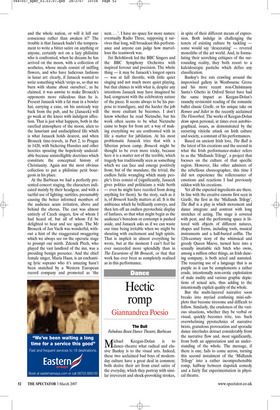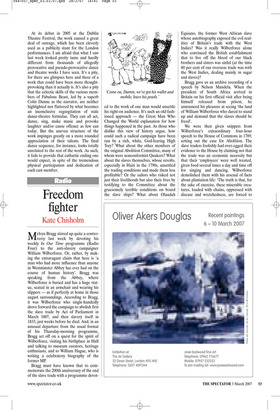Hectic romp
Giannandrea Poesio
The Bull
Fabulous Beast Dance Theatre, Barbican
Michael Keegan-Dolan is to dance–theatre what radical and elusive Banksy is to the visual arts. Indeed, these two acclaimed bad boys of modernday culture have a great deal in common; both derive their art from cruel satire of the everyday, which they portray with similar irreverent and shock-provoking strokes, in spite of their different means of expression. Both indulge in challenging the tenets of existing culture by tackling some would say ‘desecrating’ — revered monoliths of the art world. And, in formulating their scorching critiques of the surrounding reality, they both resort to a kaleidoscopic pastiche which defies any classification.
Banksy’s live rats crawling around the improvised gallery in Westbourne Grove and his more recent non-Christmassy Santa’s Ghetto in Oxford Street have had the same impact as Keegan-Dolan’s raunchy revisionist reading of the romantic ballet classic Giselle, or his unique take on Romeo and Juliet in the recently acclaimed The Flowerbed. The works of Keegan-Dolan draw upon personal, at times even autobiographical, issues, as demonstrated by the recurring vitriolic attack on Irish culture and society, a constant of his performances.
Based on ancient Irish lore, The Bull is the latest of his creations and the second in what the Irish performance-maker refers to as the ‘Midlands Trilogy’, a project that focuses on the culture of that specific region. However, like other admirers of the rebellious choreographer, this time I did not experience the rollercoaster of emotions and reactions I had previously ridden with his creations.
Yet all the expected ingredients are there. In line with the creative canons first seen in Giselle, the first in the ‘Midlands Trilogy’, The Bull is a play in which movement and dance integrate and contrast with long stretches of acting. The stage is covered with peat, and the performing space is littered with objects of different natures, shapes and forms, including tools, musical instruments and a half-buried coffin. The 12th-century story of the whimsical and greedy Queen Maeve, turned here into a sexually insatiable rich bitch who owns, among a million other things, an Irish dancing company, is both acted and narrated. The recurring use of a language that is as purple as it can be complements a rather crude, intentionally non-erotic exploitation of male nudity and various graphic depictions of sexual acts, thus adding to the intentionally explicit quality of the whole.
But the multi-layered narrative soon breaks into myriad confusing mini-subplots that become tiresome and difficult to follow. Similarly, the crudeness of the various situations, whether they be verbal or visual, quickly becomes trite, too. Such overwhelming pyrotechnics of narrative twists, gratuitous provocation and sporadic dance interludes detract considerably from the narrative flow and, most significantly, from both an appreciation and an understanding of the whole. The message, if there is one, fails to come across, turning this second instalment of the ‘Midlands Trilogy’ into a rather incomprehensible romp, halfway between slapstick comedy and a fairly flat experimentation in physical theatre. At its debut in 2005 at the Dublin Theatre Festival, the work caused a great deal of outrage, which has been cleverly used as a publicity stunt for the London performances. I am afraid that what I saw last week looked pretty tame and hardly different from thousands of allegedly provocative and pseudo-provocative dance and theatre works I have seen. It’s a pity, for there are glimpses here and there of a work that could have been more thoughtprovoking than it actually is. It’s also a pity that the eclectic skills of the various members of Fabulous Beast, led by a superb Colin Dunne as the narrator, are neither highlighted nor flattered by what becomes an inconclusive regurgitation of stale dance-theatre formulae. They can all act, dance, sing, make music and provoke laughter and/or cause offence as few can today. But the uneven structure of the work impinges greatly on a more rounded appreciation of their talents. The final dance sequence, for instance, looks totally unrelated to the rest of the work. As such, it fails to provide that cathartic ending one would expect, in spite of the tremendous physical participation and dedication of each cast member.











































































 Previous page
Previous page